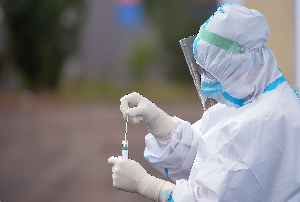Share this
sample collection & transport for infectious diseases
by Neoteryx Microsampling on Aug 16, 2021 12:00:00 PM
Serology research studies play a critical role in advancing our understanding of infectious diseases, and also in developing effective vaccines and therapies.
Serological testing of blood samples for research has proved valuable as a screening tool for detecting the antibodies raised in our bodies as an immune response to infectious diseases like the novel coronavirus. These serology studies can detect specific antibodies developed against SARS-CoV-2, the coronavirus that causes COVID-19 illness.
Serology studies are also used to analyze the longitudinal antibody responses evident in people over time as they recover from a COVID-19 infection.
The study of blood samples is critical to understanding all aspects of immune response to infectious diseases, yet researchers can only perform their analyses using high-quality blood samples from study participants. Data obtained from high-quality samples enables infectious disease researchers to determine things like how long antibodies last and how much protection they provide, as well as:
- How to identify the most vulnerable populations during a pandemic
- Which vaccine formulations provide the broadest protection
- What is the most effective timeline or schedule for booster shots
Researchers have established procedures to collect quality samples for serological testing.
Sample Collection and Processing for Serology Studies
Wet blood samples and plasma are frequently used for serology studies. However, to provide a wet blood sample or plasma sample, a study participant typically visits a medical facility for a traditional blood draw procedure via a needle-poke in the arm. The ongoing coronavirus pandemic makes many study participants reluctant to visit hospitals, blood draw centers, and clinics for fear of exposure to the virus and its variants. Additionally, traditional onsite blood sample collection is challenging for people living in remote areas with limited access to medical centers, research facilities and reliable transport.
These problems present unique challenges to researchers. Researchers must look for ways to safely access study participants in order to gather blood samples while also ensuring proper handling and transportation of the samples to keep them stable for lab analysis.
The standard procedure for handling liquid bio-fluids, such as wet blood, is cold-chain shipping. Samples are transported frozen and remain in cold storage until analysis to keep them stable and prevent bacterial growth. The cold-chain process is expensive, adding to overall costs for research and clinical trials. Even more resources are expended if some samples become unstable, or if they are rejected due to low-quality and the sample collection process must be repeated.
Dried Blood Sampling for Infectious Disease Studies
As the coronavirus pandemic continued through 2020 and 2021, many infectious disease researchers switched to dried blood sampling to overcome the challenges they were encountering with sample collection. One remote sampling technique they adopted in lieu of onsite wet blood collection was "dried blood spot." or DBS. The DBS technique enables scientists to collect samples remotely from geographically diverse populations. Study participants don’t need to visit a clinic site for assistance from a trained phlebotomist who collects the samples. Instead, tiny blood samples can be self-collected by study participants at home using an easy finger-stick method with a lancet. And, since DBS blood samples are dried before being transported, there is no need for cold-chain storage.
At first, many researchers used DBS cards, or dried blood-spot filter cards, to collect blood samples remotely from study volunteers. With this method, study participants to use a lancet and apply a few drops of blood from their fingertip onto small areas on the absorbent filter paper. The blood saturates the sampling area on the filter card and then must be left out to air-dry for a few hours before being packaged and shipped to a lab.
In the lab, the researchers must separate the small area of the sample-saturated paper from the rest of the DBS card using a manual or automated hole punch. The blood is then extracted from that tiny "punch" for testing.
This whole sequence of processes with DBS cards can compromise the quality of the blood sample & presents many challenges, including:
- Air drying the sample before shipping can increase the probability of sample contamination.
- Automated hole-punching equipment might contaminate the blood spot sample.
- Poor sample quality results if a participant doesn’t apply enough blood on the DBS card’s spotting area.
- Volumetric hematocrit bias can occur due to uneven density of the blood sample as it spreads and dries on the DBS card.
Volumetric Absorptive Microsampling
Due to the apparent challenges that DBS cards present, researchers have explored a recent advance on the dried blood sampling method. The advanced method is called volumetric absorptive microsampling, which was developed by scientists at Neoteryx. The volumetric microsampling technique is employed using Mitra® devices equipped with special VAMS® tips that can absorb the precise sample volume needed for lab analysis--without sample density issues. These small, portable devices can be sent out to study participants on their own, or as part of an at-home Mitra® Collection Kit, which also includes illustrated instructions and other supplies. The VAMS technique uses the finger-stick method to draw small drops of capillary blood from a fingertip, and is similar to dried blood sampling on a DBS card. However, the tips on Mitra devices are designed to consistently collect a fixed-volume sample to overcome the volumetric hematocrit bias seen with other sampling tools.
An added benefit is that Mitra devices are housed inside a protective plastic cartridge, into which the sample is enclosed immediately after sampling. How does the sample dry? The sampler cartridge is placed in a foil bag that includes a packet of drying desiccant to ensure the sample dries while it is in transit to the lab. No special handling during transport is required--sampled Mitra devices can be sent through the regular mail in the provided packaging.
The protective packaging, reduced handling, use of a drying desiccant, and special VAMS tip work in concert to preserve the sample’s integrity and quality for effective sequencing and analysis. Fewer samples are rejected with Mitra and VAMS compared to other dried blood sample collection techniques.
An advantage of using the Mitra Collection Kits is that study participants can collect their own samples at home. The illustrated instructions are simple, which eliminates the need for a trained nurse or phlebotomist. Participants can also be provided links provided to access microsampling "How To" videos on the Neoteryx website and YouTube.
When Mitra microsamples arrive at the designated lab, the devices are easily transferred from their plastic cartridges into a 96-Autorack™, which fits on top of a standard SLAS 96-well plate for sample extractions. The extraction can be done manually or automatically, using a liquid handling robot. According to research study surveys, Mitra with VAMS are a preferred sampling technique, due to ease of use for all end-users from start to finish — "from bench to bedside," and back to bench again for scientific analysis.

Share this
- Microsampling (206)
- Research, Remote Research (119)
- Venipuncture Alternative (105)
- Clinical Trials, Clinical Research (83)
- Mitra® Device (73)
- Therapeutic Drug Monitoring, TDM (51)
- Dried Blood Spot, DBS (39)
- Biomonitoring, Health, Wellness (30)
- Infectious Disease, Vaccines, COVID-19 (24)
- Blood Microsampling, Serology (23)
- Omics, Multi-Omics (21)
- Decentralized Clinical Trial (DCT) (20)
- Specimen Collection (18)
- Toxicology, Doping, Drug/Alcohol Monitoring, PEth (17)
- Skin Microsampling, Microbiopsy (14)
- hemaPEN® Device (13)
- Preclinical Research, Animal Studies (12)
- Pharmaceuticals, Drug Development (9)
- Harpera Device (7)
- Industry News, Microsampling News (5)
- Antibodies, MAbs (3)
- Company Press Release, Product Press Release (3)
- Environmental Toxins, Exposures (1)
- July 2025 (1)
- May 2025 (1)
- April 2025 (2)
- December 2024 (2)
- November 2024 (1)
- October 2024 (3)
- September 2024 (1)
- June 2024 (1)
- May 2024 (1)
- April 2024 (4)
- March 2024 (1)
- February 2024 (2)
- January 2024 (4)
- December 2023 (3)
- November 2023 (3)
- October 2023 (3)
- September 2023 (3)
- July 2023 (3)
- June 2023 (2)
- April 2023 (2)
- March 2023 (2)
- February 2023 (2)
- January 2023 (3)
- December 2022 (2)
- November 2022 (3)
- October 2022 (4)
- September 2022 (3)
- August 2022 (5)
- July 2022 (2)
- June 2022 (2)
- May 2022 (4)
- April 2022 (3)
- March 2022 (3)
- February 2022 (4)
- January 2022 (5)
- December 2021 (3)
- November 2021 (5)
- October 2021 (3)
- September 2021 (3)
- August 2021 (4)
- July 2021 (4)
- June 2021 (4)
- May 2021 (4)
- April 2021 (3)
- March 2021 (5)
- February 2021 (4)
- January 2021 (4)
- December 2020 (3)
- November 2020 (5)
- October 2020 (4)
- September 2020 (3)
- August 2020 (3)
- July 2020 (6)
- June 2020 (4)
- May 2020 (4)
- April 2020 (3)
- March 2020 (6)
- February 2020 (3)
- January 2020 (4)
- December 2019 (5)
- November 2019 (4)
- October 2019 (2)
- September 2019 (4)
- August 2019 (4)
- July 2019 (3)
- June 2019 (7)
- May 2019 (6)
- April 2019 (5)
- March 2019 (6)
- February 2019 (5)
- January 2019 (8)
- December 2018 (3)
- November 2018 (4)
- October 2018 (7)
- September 2018 (6)
- August 2018 (5)
- July 2018 (8)
- June 2018 (6)
- May 2018 (5)
- April 2018 (6)
- March 2018 (4)
- February 2018 (6)
- January 2018 (4)
- December 2017 (2)
- November 2017 (3)
- October 2017 (2)
- September 2017 (4)
- August 2017 (2)
- July 2017 (4)
- June 2017 (5)
- May 2017 (6)
- April 2017 (6)
- March 2017 (5)
- February 2017 (4)
- January 2017 (1)
- July 2016 (3)
- May 2016 (1)
- April 2016 (2)



No Comments Yet
Let us know what you think